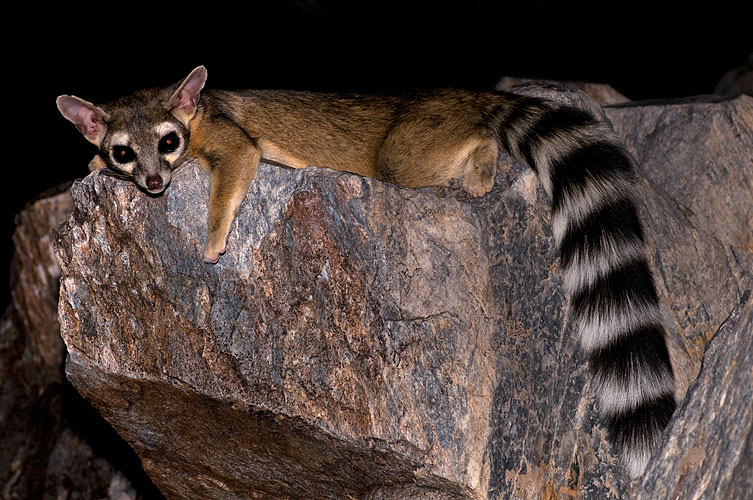|
Procyonidae
Procyonidae is a New World family of the order Carnivora. It comprises the raccoons, ringtails, cacomistles, coatis, kinkajous, olingos, and olinguitos. Procyonids inhabit a wide range of environments and are generally omnivorous. Characteristics Procyonids are relatively small animals, with generally slender bodies and long tails, though the common raccoon tends to be bulky. Because of their general build, the Procyonidae are often popularly viewed as smaller cousins of the bear family. This is apparent in their German names: a raccoon is called a ''Waschbär'' (washing bear, as it "washes" its food before eating), a coati is a ''Nasenbär'' (nose-bear), while a kinkajou is a ''Honigbär'' (honey-bear). Dutch follows suit, calling the animals ''wasbeer'', ''neusbeer'' and ''rolstaartbeer'' respectively. However, it is now believed that procyonids are more closely related to mustelids than to bears. Procyonids share common morphological characteristics including a shortened ... [...More Info...] [...Related Items...] OR: [Wikipedia] [Google] [Baidu] |
Carnivora
Carnivora is a Clade, monophyletic order of Placentalia, placental mammals consisting of the most recent common ancestor of all felidae, cat-like and canidae, dog-like animals, and all descendants of that ancestor. Members of this group are formally referred to as carnivorans, and have evolved to specialize in eating flesh. The order is the fifth largest order of mammals, comprising at least 279 species. Carnivorans live on every major landmass and in a variety of habitats, ranging from the cold polar regions to the hyper-arid region of the Sahara Desert to the open seas. They come in a very large array of different body plans in contrasting shapes and sizes. Carnivora can be divided into two subclades: the cat-like Feliformia and the dog-like Caniformia, which are differentiated based on the structure of their ear bones and cranial features. The feliforms include families such as the felidae, cats, the hyenas, the mongooses and the viverridae, civets. The majority of felifor ... [...More Info...] [...Related Items...] OR: [Wikipedia] [Google] [Baidu] |
Bassariscus
''Bassariscus'' is a genus in the scientific classification, family Procyonidae. There are two extant species in the genus: the ring-tailed Cat, ring-tailed cat or ringtail (''B. astutus'') and the cacomistle (''B. sumichrasti''). Genetic studies have indicated that the closest relatives of ''Bassariscus'' are raccoons, from which they diverged about 10 million years ago in the Tortonian Age of the Miocene. The two lineages of ''Bassariscus'' are thought to have separated after only another two million years, making it the extant procyonid genus with the earliest diversification. Later diversification in the genus in the Pliocene and Pleistocene saw the emergence of two extinct species, ''Bassariscus casei'' and ''Bassariscus sonoitensis'', respectively. Due to the more digitigrade stance of their legs compared to the plantigrade stance of other members of Procyonidae, some taxonomies place the genus as a separate family, ''Bassaricidae.''. The name is a Greek word for fox ("bassari ... [...More Info...] [...Related Items...] OR: [Wikipedia] [Google] [Baidu] |
Bassaricyon
The genus ''Bassaricyon'' consists of small Neotropical procyonids, popularly known as olingos (), cousins of the raccoon. They are native to the rainforests of Central and South America from Nicaragua to Peru. They are arboreal and nocturnal, and live at elevations from sea level to 2,750 m. Olingos closely resemble another procyonid, the kinkajou, in morphology and habits, though they lack prehensile tails and extrudable tongues, have more extended muzzles, and possess anal scent glands. However, the two genera are not sisters. They also resemble galagos and certain lemurs. Species There is disagreement on the number of species in this genus, with some taxonomists splitting the populations into as many as five species (adding ''B. pauli'' to the list below), two species (dropping ''B. medius'' and ''B. neblina''), or just a single species (''B. gabbi''). Until recently, only the northern olingo (''B. gabbii'') was particularly well-known, and it was usually confusi ... [...More Info...] [...Related Items...] OR: [Wikipedia] [Google] [Baidu] |
Order (biology)
Order ( la, wikt:ordo#Latin, ordo) is one of the eight major hierarchical taxonomic ranks in Linnaean taxonomy. It is classified between Family_(biology), family and Class_(biology), class. In biological classification, the order is a taxonomic rank used in the classification of organisms and recognized by the nomenclature codes. An immediately higher rank, superorder, is sometimes added directly above order, with suborder directly beneath order. An order can also be defined as a group of related families. What does and does not belong to each order is determined by a taxonomist, as is whether a particular order should be recognized at all. Often there is no exact agreement, with different taxonomists each taking a different position. There are no hard rules that a taxonomist needs to follow in describing or recognizing an order. Some taxa are accepted almost universally, while others are recognized only rarely. The name of an order is usually written with a capital letter. Fo ... [...More Info...] [...Related Items...] OR: [Wikipedia] [Google] [Baidu] |
Family (biology)
Family ( la, familia, plural ') is one of the eight major hierarchical taxonomic ranks in Linnaean taxonomy. It is classified between order and genus. A family may be divided into subfamilies, which are intermediate ranks between the ranks of family and genus. The official family names are Latin in origin; however, popular names are often used: for example, walnut trees and hickory trees belong to the family Juglandaceae, but that family is commonly referred to as the "walnut family". What belongs to a family—or if a described family should be recognized at all—are proposed and determined by practicing taxonomists. There are no hard rules for describing or recognizing a family, but in plants, they can be characterized on the basis of both vegetative and reproductive features of plant species. Taxonomists often take different positions about descriptions, and there may be no broad consensus across the scientific community for some time. The publishing of new data and opini ... [...More Info...] [...Related Items...] OR: [Wikipedia] [Google] [Baidu] |
_(white_background).jpg)
.jpg)


